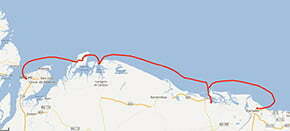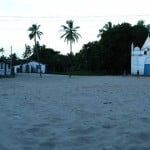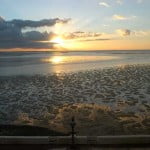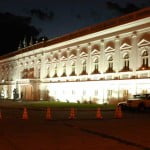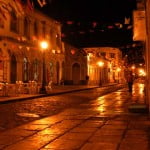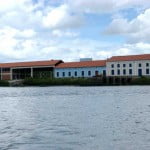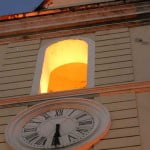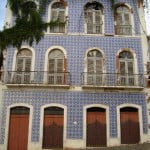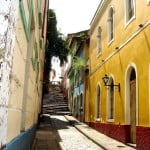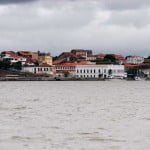Saturday, 02 – 07 – 2005.
We arrived in São Luis three days ago on Wednesday 29th. And we shot the historical center of the city acknowledged by UNESCO as a Historic Site of Humanity. We were guided by Luiz Phelipe Andrés from Minas Gerais. He is very fond of Maranhão and the Brazilian historic sites as a whole and chose to live in São Luis. He was so deeply involved with the city that he became the State Secretary of the Culture Department some years ago. After that he was the coordinator of a study required by UNESCO for every city that aims at being a Historic Site of Humanity. Today, Luiz Phelipe is the superintendent of Maranhão”s historic site. We were in excellent company.
He took us to some of the most emblematic buildings such as Palácio dos Leões (Palace of Lions), today”s government headquarters, Mother of God church, Mercês” Convent, Ribeirão”s Fountain, etc. We walked along the most important streets and heard explanations either about Cantaria”s stones, a sort of Portuguese marble brought as gold reserve in the hold of ships and were used to cover sidewalks, or about the glazed tiles on the richest building façades which made them not only more beautiful but also showed the owner”s higher status. Additionally, they resisted better than the plaster of the other houses and kept them cooler since they reflected the sun and protected the walls from heating up like pizza ovens. Counting on Luiz” help was excellent. I”m sure the TV program in which this city is shown will be very interesting and full of details with our guide”s explanations as the leading thread.
We also visited two cities on the other side of São Luis island alongside the bay of São José: Raposa and São José do Ribamar. Both were originally fishing colonies and are well known because of the great number of bianas, these beautiful traditional sailboats with a risen prow upright and not “V-shaped”, like the traditional canoes, they are flat, known as “slipper foot” prows. Originally, these bianas are from Ceará, but they crossed the coast of Piauí, were very well accepted in Maranhão where they probably became one of the favorite boats of non industrial fishermen. And they are really beautiful (see pictures). They are small and have two sails (stay and gaff), both the rudder and the hull are big, and are very elegant. It was really wonderful to see those boats when we were coming back after a fishing day at Raposa beach. We decided to visit a great friend of Luiz Phelipe”s, a biana builder, João dos Reis Calixto, known as Mestre Jonas (see pictures), who at the age of 82 is extremely dynamic, intelligent and very nice. He dignifies his craftsmanship up to the present moment, ship carpentry, building the most beautiful bianas that sail there.
But there is more: in São Luis we visited the apple of Luiz Phelipe”s eyes, the shipyard school, designed and built by him in an old decaying building (where there was a rice processing factory) which is brand new today after having been renovated. This shipyard is L.Phelipe”s great and main contribution to preserve centennial non-industrial shipbuilding techniques being threatened today. This man from Minas Gerais (a Brazilian state that is not on the coast) “suffers from being away from the sea” according to his own words.
The idea is simple and ingenious: to gather in the shipyard school the best shipbuilders who are still working not only to build boats but also to teach to the younger ones how to build them. Today they work in open air uncomfortable places such as mangroves or even in their backyards. One of the drawbacks is to work in the rain. They have just a few old rudimentary tools, and have neither comfortable working conditions nor any security at all. There are lodging rooms, a restaurant and a covered area leading through a ramp to the sea in this shipyard building in São Luis. These favorable conditions remove these carpenters from misery and give some dignity to their work.
After these visits our program about São Luis was concluded. Now we had to go southwards on the Brazilian coast. Thus, this morning at 5:00 a.m. the anchor was lifted towards the Island of Santana, 45 miles down São Luis.
The Endless Sea crew was kind of exhausted. We had been to a party at Mercês” Convent where we saw a marvelous show performed by some of the most famous groups of Boi Bumba from Maranhão. I won”t talk much about it. I just want to say that I intend to come back and bring my kids to see this show. And I hope the party is kept like the one I saw, with no influences that end by changing its originality, turning this popular celebration into a “Hollywood” type event such as our carnival.
Since we were all very tired, Paulina ,film maker Cardozo and I slept until we were about to arrive at the Island of Santana.
I just woke up 10 miles before our arrival, which means we have sailed for an hour or so. In spite of that, I could watch our arrival at the island. As usual, this is the most critical moment in navigation. People normally think that accidents occur in the sea, but 90% occur when the boat is approaching land. Fortunately, during this stage of the journey, we have aboard a sailor who knows this area very well. There is a curious thing about him, his nickname, Chico Bem-Feito (Chico – from Francisco -Well-Built). We had no problems with our arrival.
Then we sailed for over half an hour through a narrow canal and eventually we dropped anchor in front of the Island of Santana”s lighthouse.
The Endless Sea had hardly anchored when we got down to visit the village and the lighthouse. We insisted on going up the 49 meters of the tower on whose end is the mechanism that helps the sailors with the light. There is a fascinating view from the top of the tower and we had a nice and funny talk with sergeant Meireles, appointed to be in charge of that equipment. But, I won”t tell you right now the stories I was told. I”m very tired. It”s 11 p.m. and we had a hard day. It”s time to rest. I”ll tell you more tomorrow.
Sunday, 03 – 07 – 2005.
Right after breakfast we went out again to talk to sergeant Meireles who has been here for a month and will stay five more months until the full period of his mission in Santana is fulfilled as it is required by the Brazilian Navy.
Meeting and talking to people like him is quite peculiar and interesting to us. It”s like a novel or a movie.
Sergeant Meireles is euphoric when he sees us and he cannot hide it. He is a captivating, very talkative person. He tells stories about the island, about his family and about coming to the island. Nostalgically, he remembers places he has been to during his navy journeys and he is sad to hear that we are leaving today. But he doesn”t hide that from us, he says quite frankly that he is happy to talk to the few visitors who rarely come.
Meireles took us to Getúlio”s house. A seventy-six year old man married to Dona Lurdes (see pictures) who is currently trying to breed mullets in captivity after having failed with the crustacean culture. The couple told us their stories all morning long. We visited the breeding tanks and after we were offered coffee with cake, we left. In the fishermen”s village there are between 150 and 200 inhabitants, not more, and like all the other communities we have seen so far, this is another community of excluded people. It is sad to see how the government abandons the fishermen. Many times they live near big cities, but the access is difficult, therefore they are abandoned. Most of them have no papers. Doctors are rarely available, sometimes there are schools but in bad situation, poverty is the rule. The climate is inhospitable, the sun strong and everlasting. Shadows are not always available. The wind blows constantly, almost 24 hours per day. And there is more. In these areas the government is absent. People survive because they are strong.
These fishermen resulting from the miscegenation of native people, Europeans and slaves come from the first colonization groups. They are a living legend of centennial customs and traditions. Thus, sometimes I have an ambiguous feeling about them. I”m moved either by pity or by admiration. The explanation for this duality can be found not only in their amazing past but also in the fact of being abandoned, consequently in decay.
During the first two centuries after the discovery, Brazil was exactly like this part of the country we have visited. Since that time, the villages were connected by boats built by the inhabitants themselves. They were designed according to the specific navigation conditions of the area, with different climate and geography. This is the reason why this abundant diversity of typical boats as well as their natural sailing skills can be found here today.
Caiçaras are above all non industrial fishermen who work hard but the results could be much better if the government cared just a little. According to the study “Fresh Water and Marine Fishing Estimates” by José Ribeiro Borghetti from MAARA”s Fishing and Aquiculture Advisory Committee (Brasília), in Brazil there are 700 thousand fishermen. If we think in terms of people who depend on this activity, they make up a total of 4 million, and 60% of the fishing activity is non industrial. Industrial fishing in Brazil has always been and will always be a non significant activity. For the simple reason that the Brazilian coast doesn”t abound in fish, several studies have shown that. Nevertheless, if there is public investment, it is the industrial fishing that benefits. In the seventies, SUDEPE spent millions when generous financing sums were offered to industrial fleets. These sums were required and obtained by entrepreneurs from other businesses who invested very little in this specific business. Although SUDEPE (Agency for the Development of the Fishing) had been created by the military regime during dictatorship, it was a disaster. It ended by being extinguished: too much money spent for very little results.
Consequently our public authorities never invested in non industrial fishing. They never offered public funds for generators, ice-chambers, warehouses, etc. On the contrary, many times they didn”t help by requiring plans signed by engineers to give permits. But the boats are built by master craftsmen (most of them illiterate) having remarkable skills and know-how. In spite of that, this absurd requirement was kept and the fleet was illegal. Sometimes, public authorities, under the guise of “safety standards”, required that these miserable people had expensive and sophisticated rescue equipment they couldn”t afford available aboard. When the public authorities don”t bother, like in these cases, they don”t help either. The fisherman has to find a way to sell his products by his own means. Regardless of these setbacks, it represents 60% of the fishing in this country. Imagine what could be done if the government helped and didn”t block its way…
Here in Santana, we saw the problems caused by this lack of infrastructure. One of these days, a fisherman was lucky and took from the sea one ton of cavalla. His sailboat (biana) could barely carry the fish to the island of Santana, where he lives. He was not happy, he was desperate because he ran out of diesel oil and was looking for some to use the motor and take the fish faster in order to avoid spoiling until the arrival at the market of São José de Ribamar, near Santana. If sergeant Meireles had not given him fuel, this fisherman would have seen the product of his work spoiled because he had no means to keep it fresh. That”s it. It is possible to get public money for political parties, it is just a matter of talking to the right “men”. But money for non industrial fishing, public waste system and garbage collection or for many important things public authorities should be in charge of, don”t dare to think about.
Well, we had to continue our journey. We lifted the anchor and started the 25 mile trip to Primeira Cruz on the other side of the bay of Tubarão (Shark).It was an amazing trip. We sailed alongside the waves that crash in the estuary due to obstruction. It was like this all the time. On the left side of the Endless Sea the waves crashed. On the right side, if we kept on forcing, we would ground.
We went on alongside this thin band trying to pay attention to the information given by Chico Well-built. Normally, people from Maranhão have no accent, they speak in a clear and natural way, but this fellow is out of tune even when he says “good morning”. He speaks fast and it is like a melody, what makes understanding more difficult. On the first day, I couldn”t understand a single sentence. I had already given up, but today, paying more attention, I can understand a little of what he tries to explain to us. Eventually, we arrived safe and sound at the beautiful and picturesque village of Primeira Cruz, at the beginning on the north side of Lençóis Maranhenses. This is Maranhão”s most famous area with dunes and lakes. On the other end, 45 miles in the south, is Barreirinhas.
Primeira Cruz is beautiful, it looks well organized, although the beginning of a slummy process is found on the outskirts. And it is quite picturesque. It was built alongside the banks of the Piriá river. When we arrived it was getting dark and that”s the reason why the three of us didn”t leave the boat. Later, we celebrated Paulina”s 27th birthday. We had a cake made by Alonso and champagne. Then I went to the plotting table to report the day we had had. Now, I will have a good bath in the river and then bed.
Monday, 04 – 07 – 2005.
These two last days haven”t been easy for me. I got a nasty flu in São Luis and boarded like this. Fever and all the rest. And on the boat, I am either under the sun or the wind, sometimes both. Even if I protect myself under awnings or looking for a shadow as soon as I leave the boat, wearing long sleeve shirts, hat and sunscreen, I”m always exposed and this makes the healing process difficult. But let”s get to the point.
First thing in the morning, we met a local sailor who would take us 10 miles up the river until Caetés, an old warehouse from Petrobrás that turned into a village. A 4 x 4 car was waiting for us to take us to Santo Amaro, the water-tables north end, and the city where the film in which Fernanda Montenegro and Fernanda Torres perform was shot. The Endless Sea is anchored in front of Primeira Cruz where the depth is good enough for the 1 meter and 80 cm gauge.
At 10 a.m. a biana stopped aside and went up the river with us for over an hour and left us at the drowsy Caetés. It was extremely hot as usual. As soon as we left the boat, I looked for a shadow around. And there was none. I looked around again and found a hut surrounded by wattle, a sort of palisade with a bar board. I was a bit distrustful because of the negligence and went closer, but I saw it was in fact a bar. I went in. There was a shadow, three children, one of them was a baby under the age of one and two animals, a dog infected with fleas and a weak pig. Everything in the same room. Ah, I forgot to say that the owner was swinging on a hammock in the middle of all that, and reading comics about biblical legends. I know because I checked it.
It reminded me of a Dirkou”s bar in Libia”s desert where I had been one evening during the Paris-Dakar journey. But I got to the conclusion that it was worse. Anyway, I picked up a chair and sat at the only table there was in the bar and ordered a cold soda which drove the owner mad. Lying on the hammock, he heard that and mumbled something I couldn”t understand to the woman that was bathing one of the children behind a cement wall. Eventually, I had my coke, thus I could satisfy my thirst. But the driver we had hired didn”t come. Fortunately, two hours later two 4 x 4 cars came bringing policemen who were escorting the money from the bank. We made a deal with the driver of one of the cars and went to Santo Amaro, an hour from there. On our way we found parts of thick forest, soft sand, sandbar, stretches of sand, fields and rivers of different sizes. An adventure. We eventually arrived. We visited the film location, the impressively big dunes with lagoons (see pictures). We achieved today”s goal, the shootings were successful.
At 8 p.m. we returned to the Endless Sea. Everybody was tired but happy.
Tuesday, 05 – 07 – 2005.
Right after dawn, Alonso called me to say the bianas were leaving for fishing. I picked up my camera immediately, called film maker Cardoso and we followed them by boat. They had already reached the mouth of the river.
How wonderful! How beautiful! They are both rustic and functional. I took hundreds of pictures and Cardoso shot a lot too. Have a look at the pictures to see how colorful they are, the dramatic shape of the sail, their drawings on the horizon and how skillfully they are conducted. It was a fantastic morning. Most of the sailing canoes in this area are either spike sail barges or sailing or motor bianas with or without housing, as well as some small boats with chicken feather (pena de galinha) sail, the same that is used in rafts, those boats that are built in Barreirinhas. I admired them from the boat for hours, talked to the masters, shot and took pictures. I went back to the Endless Sea and was dumbstruck with such beauty and looking forward to have one of those rafts one day. I would make a good impression at Ilhabela”s Sailing Week…
We protected ourselves from the burning heat, which was even harder with the wind. After that we went to the village. Primeira Cruz (First Cross) is called like this because the Portuguese put their first landmark here, when they were on their way to São Luis, in 1614, to free the city from the French.
It is a charming village, full of coconut palms alongside the river which is relatively large here. There is a lot of green area around and a few dunes behind. In general, the city is clean, although we noticed that there is no sanitation system, no garbage collection, etc. But local inhabitants seem to be aware of their environment and take care of it, we can see that. Most of the streets are paved, but some in the surroundings are covered with sand. There are about 11.000 people who live here. We visited a local salt mine, a typical industrial activity in all this area, and a non industrial shipyard.
We left the village with a very good impression of it. I loved the visit and the fact of having seen the tradition and the manufacture of non industrial boats, all this surrounded by a wonderful scene.
We returned in the evening and prepared the boat for the journey of the following day. We are going to go about 45 miles down the coast until the mouth of the Preguiças river which is really difficult to enter. It is very windy and not deep enough and most of the mouth is obstructed. We will try anyway. All the river is very beautiful, I have already been there before and if we go up the riverbed, we can arrive at Barreirinhas, a town near the south end of Lençóis Maranhenses.
I”ll go there to see what the narrows are like, to feel them, if it is easy, we”ll enter them, if not, we”ll go towards Tutóia”s narrows, the beginning of Parnaíba”s Delta.
Wednesday, 06 – 07 – 2005.
Thursday, 07 – 07 – 2005.
2:20 p.m. I have some free time again to tell what happened to us during this period of time.
We weren”t able to enter the narrows of Preguiças. It was too shallow, the waves crashed, but the wind helped us. We had an east-southeast wind which is weak for the local conditions, ranging from 10 to 15 knots. A wind that is not strong enough to make the sea go up. We navigated with small waves from one meter to one meter and a half high, at most.
The Endless Sea was in front of the narrows at a depth of two meters and a half and as we went forwards I realized that I couldn”t see the entrance of the canal and since the waves were crashing around us, I decided to give up.
“Alonso, add 180 degrees, we are going to abort!”, I said, asking him to add 180 degrees to our destination to put the Endless Sea about.
We sailed out for about 6 or 8 miles, then we went to the narrows of Tutóia, 30 miles down. We arrived in the evening, around 9 p.m. It was dark and there was no moon. When we dropped the anchor, two miles away from the city, it was about 10. The sea was making the sailboat “slip” on the waves, while on the horizon, lightning and thunder announced that the Pirajá was about to arrive. I added those signals and tried not to look tense, I starred at the wind counter and it was showing 20, 25 knots. Everybody was tired after having sailed all day long. However, we couldn”t relax that night. I asked everybody to make a two-hour shift. There were four of us and it was 10 p.m., if each of us lost only two hours of sleep, at 6 a.m., after dawn, we would be ready to enter the narrows. Then I went to bed.
I woke up this morning without having noticed I had not been called for my shift. Alonso and Chico Well Built didn”t need me. How nice! It is awful to be on the cockpit during the night exposed to the rain and wind, completely alone, and the only company you have is hearing the tune modulation produced by each variation of the wind on the sailboat stays.
Since all that had gone, I just had to lift the anchor and enter the narrows. Although the nautical map had the 1978”s measurements and the depth was very low, we entered them easily. We went from the narrows to the city with a minimum depth of three meters. Additionally, when we arrived, we found a place in the Comum river which flows through the city where it was six-meters deep. That”s where we dropped the anchor.
Now it is 3:14 p.m. We are waiting for a Voadeira (a stern motor boat) that I had hired to take us to Cajú island in the middle of Parnaíba”s Delta, about 25 miles away from here. While Marzão rests in Tutóia, the crew goes to the island for some shooting. I”ll talk to you again when I come back.
Friday, 08 – 07 – 2005.
According to the board clock, it was 7 p.m. We have just returned from Caju island. We spent a beautiful night there. Early in the morning we went horseback riding and went through all the ecosystems of the island. There are plenty of them: beaches, mangroves, dunes, the forest, fields, sand bars and flooded areas. It is great on a single day to go through so many different areas, this shows how rich the island is and the diversity of the green covers. It is also good to be able to show in our program such a wide diversity in such a small area. The Caju island has 100 square kilometers and it is one of the eighty islands in Parnaíba”s Delta. The hotel where we were is small, consequently it affects very little the environment. It would be marvelous if all the hotels on the coast were as conscientious as this one. It is useless to build a huge and wonderful tourist complex in fragile coastal areas (as it is normally the case) without an infrastructure that is good enough to accommodate thousands of tourists. In very little time, the area is deteriorated and the previous conditions will never be found again. First, you have to check what the conditions are, then open the doors. Thus the tourist will see an original area with the main features preserved. We hope we won”t see here in northern Brazil, whose coastal zone has not yet been fully occupied, the same deterioration process that occurred in the southeast because of a non planned occupation of the coast. This resulted from real estate speculation, lack of information, the authorities” irresponsibility, etc. Nobody has the right to spoil public areas such as islands, coasts or beaches by building and changing the scene that belong to the Brazilians since the world was created thousands of years ago. And that”s exactly what happened on the coast of São Paulo, Rio de Janeiro and that of many other states of Brazil. And the problem is not only esthetic. 90% of the marine life starts in the coastal zone and it is exactly the most fragile part and where the impacts are greater. The disorganized occupation of the coast contributes dangerously to turn the oceans into a huge inanimate desert. To me, it is also a crime against humanity, seeing that the seas don”t belong to any specific country but to all those who live in this planet. Maybe this is the main issue, the disastrous occupation of the southeastern coast, that made me make this journey of over an year going down the coast from the north to the south to attract people”s attention and at the same time accuse the crimes committed during the occupation.
It is a daring and maybe quixotic task, I know that, but you have to believe in what you do, otherwise, it”s better to stay home with “an open mouth full of teeth waiting for death to arrive”, this is what my friend Raul Seixas would say.
Well, tonight we will navigate again. We will go 55 miles down until Luis Correia, the first of the five arms that form Parnaíba”s Delta. We were in Tutóia, the fifth, and last one. We will sail away from the other three until we enter the port again. The Endless Sea will wait there until the next stage of our journey that will take us to the coast of Ceará.
I will tell you about that tomorrow.
Saturday, 09 – 07 – 2005.
We met difficult sailing conditions: strong and constant southeast winds right on our bow ranging from 20 to 25, 26 knots with gusts. Since we were going the opposite direction, the winds reached 31 knots at the peaks and made the sea go up. The waves came from the south and were from two to three meters high. We swung a lot. And went more slowly than usual. Sometimes GPS marked four, five knots, whereas our normal speed would be seven knots…
The important thing is that the Endless Sea, that is away from home for almost a year, performed beautifully, it didn”t care and went on.
At the end of the day we arrived at Luis Correia, a small coastal town in the state of Piauí, the fourth state we visited during our journey.
On our next trip, we”ll go to Fortaleza.


